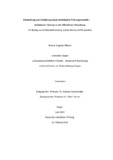Citation link:
http://dx.doi.org/10.25819/ubsi/10602Files in This Item:
| File | Description | Size | Format | |
|---|---|---|---|---|
| Dissertation_Angress-Pletsch_Simone.pdf | 4.22 MB | Adobe PDF |  View/Open |
| Dokument Type: | Doctoral Thesis | metadata.dc.title: | Entwicklung und Validierung eines Ambidextrie Führungsmodells - Ambidextre Führung in der öffentlichen Verwaltung | Title addition: | ein Beitrag zur Ambidextrieforschung auf der Multi-Level-Perspektive | Other Titles: | Development and validation of an ambidextrous leadership model - ambidextrous leadership in public organizations A contribution to ambidexterity research from a multi-level perspective | Authors: | Angress-Pletsch, Simone | Institute: | Fakultät V - Lebenswissenschaftliche Fakultät | Free keywords: | Ambidextrie Führungsmodell, Ambidextre Führung, Paradoxe Führung, Sowohl-Als-Auch-Führung, Ambidextrie, Ambidexterity leadership model, Ambidextrous leadership, Both/and leadership, Ambidexterity, Paradoxical leadership | Dewey Decimal Classification: | 150 Psychologie | GHBS-Clases: | HWI | Issue Date: | 2024 | Publish Date: | 2024 | Abstract: | Organisationen, die gleichermaßen erfolgreich ihr gegenwärtiges Kerngeschäft managen (Exploitation) als auch innovativ und kreativ die Gestaltung ihrer Zukunft vorantreiben (Exploration), gelten als ambidexter beziehungsweise beidhändig. Die Ambidextrie Forschung beschäftigt sich mit der Frage, wie Organisationen, Führungskräfte und Individuen konkurrierenden, widersprüchlichen oder unvereinbaren Zielen in Organisationen gerecht werden und mit einhergehenden Spannungen konstruktiv umgehen können. Die unvorhersagbaren Entwicklungen und Krisen der letzten Jahre, wie beispielsweise die Pandemie und der Krieg in der Ukraine und in Nahost, haben nochmals gezeigt, dass sich alle Organisationen mit widersprüchlichen Zielen, Unsicherheit und Paradoxien auseinandersetzen müssen. Zahlreiche Studien bestätigten die positiven Auswirkungen von Ambidextrie auf Erfolgsparameter von Organisationen und schreiben Führungskräften einen großen Einfluss auf die Ambidextriefähigkeit ihrer Organisationen zu. Jedoch fehlen wissenschaftliche Operationalisierungen, die das theoretische Konstrukt der Ambidextrie in beobachtbare Führungsverhaltensweisen herunterbrechen. Ziel der vorliegenden quantitativen Forschungsarbeit war es, ein möglichst konkretes, handlungsleitendes ambidextres Führungsmodell für effektives Führungshandeln zu entwickeln und zu erproben. Auf Grundlage bewährter Theorien aus Organisations-, Führungs-, und Psychologieforschung sollte es konkrete Ansatzpunkte liefern, wie Führungskräfte die unterschiedlichen Anforderungen aus Kerngeschäft und Zukunftsgestaltung balanciert bedienen, unterschiedliche Rollen und Schwerpunkte, je nach Kontexterfordernis, einnehmen, notwendige Entscheidungen treffen und dabei Widersprüche und Spannungen mit einem Sowohl-Als-Auch-Mindset konstruktiv managen können. Als Operationalisierung des Führungsmodells wurde eine Standortbestimmung als Messinstrument konstruiert und empirisch validiert, damit auf dieser Basis Führungsverhalten beobachtet, reflektiert, besprochen und weiterentwickelt werden kann. Sowohl Führungsmodell als auch Standortbestimmung werden seit Anfang 2022 in einer großen deutschen Behörde, der Bundesagentur für Arbeit, eingesetzt. Erste Gruppenvergleiche haben gezeigt, dass das Ambidextrie Führungsmodell auch auf Führungskräfte anderer Organisationen und Branchen übertragen werden kann. Organizations that are both successful in managing their current core business (exploitation) and in innovately shaping their future (exploration) are considered ambidextrous. Ambidexterity research deals with the question of how organizations, managers and individuals handle competing, contradictory or irreconcilable goals and deal constructively with the associated tensions. The unpredictable developments and crises of recent years, such as the pandemic and the war in Ukraine and the Middle East, have once again shown that all organizations have to deal with conflicting goals, uncertainty and paradoxes. Numerous studies have confirmed the positive effects of ambidexterity on the success parameters of organizations and attribute a major influence on the ambidexterity capability of their organisations to managers. However, there is a lack of scientific operationalisations that break down the theoretical construct of ambidexterity into observable leadership behaviours. The aim of this quantitative research project was to develop and test an ambidextrous leadership model for effective leadership behaviour that is as concrete and action-guiding as possible. Based on proven theories from organizational, leadership and psychological research, it should provide concrete starting points on how managers can balance the different requirements of the core business and shaping the future, take on different roles and priorities depending on the contextual requirements, make necessary decisions and constructively manage contradictions and tensions with a both/and mindset. As an operationalisation of the leadership model, an assessment was constructed and empirically validated as a measuring instrument so that leadership behaviour can be observed, reflected upon, discussed and further developed on this basis. Both the leadership model and the assessment have been used in a large German authority, the Federal Employment Agency, since the beginning of 2022. Initial group comparisons have shown that the Ambidextrie leadership model can also be transferred to managers in other organizations and sectors. |
DOI: | http://dx.doi.org/10.25819/ubsi/10602 | URN: | urn:nbn:de:hbz:467-28240 | URI: | https://dspace.ub.uni-siegen.de/handle/ubsi/2824 | License: | http://creativecommons.org/licenses/by-nc-nd/4.0/ |
| Appears in Collections: | Hochschulschriften |
This item is protected by original copyright |
Page view(s)
166
checked on Jan 18, 2025
Download(s)
134
checked on Jan 18, 2025
Google ScholarTM
Check
Altmetric
This item is licensed under a Creative Commons License


